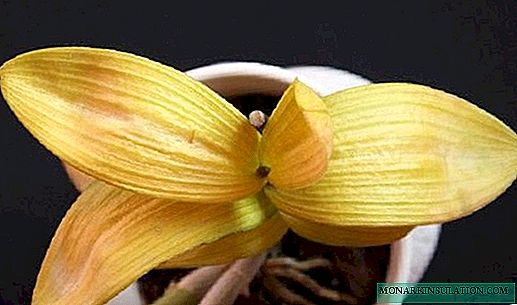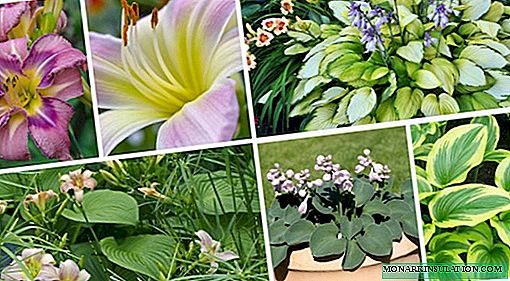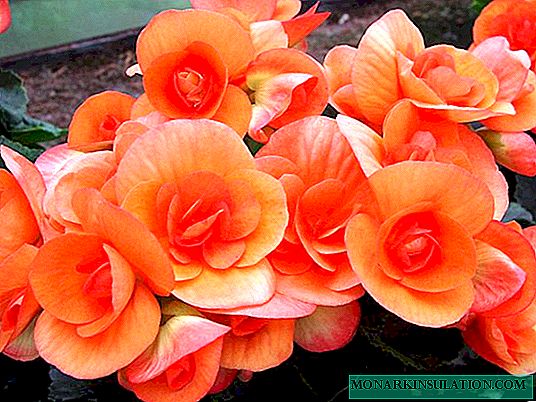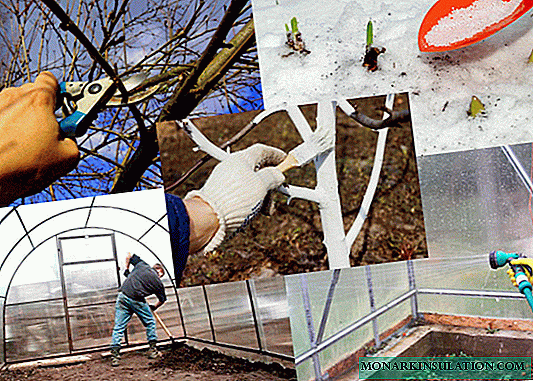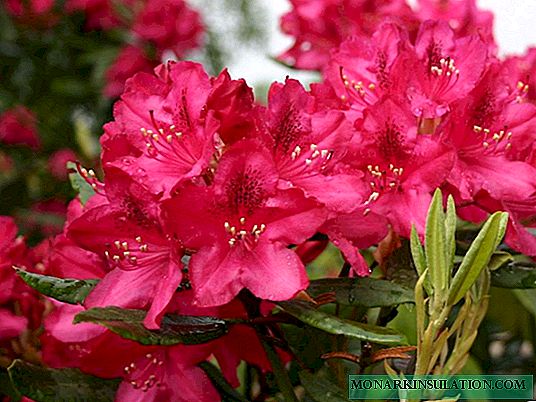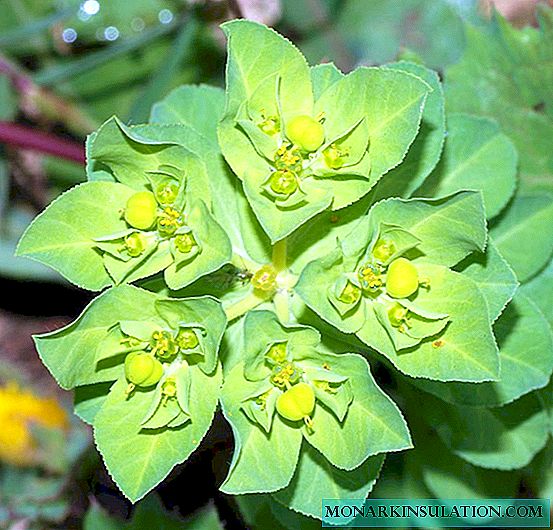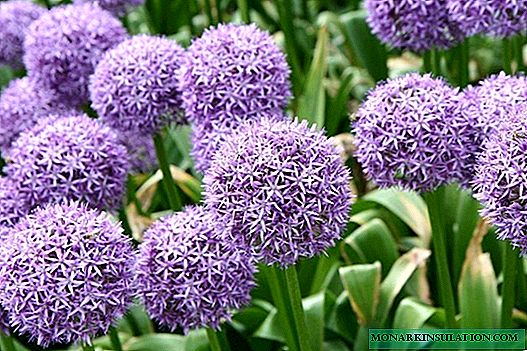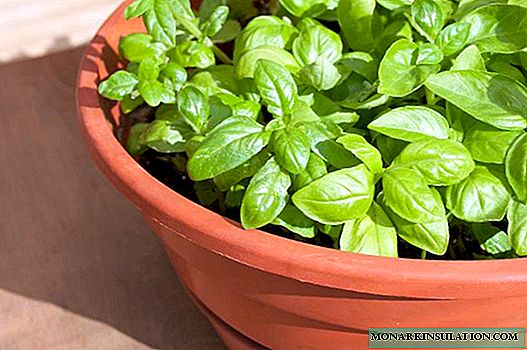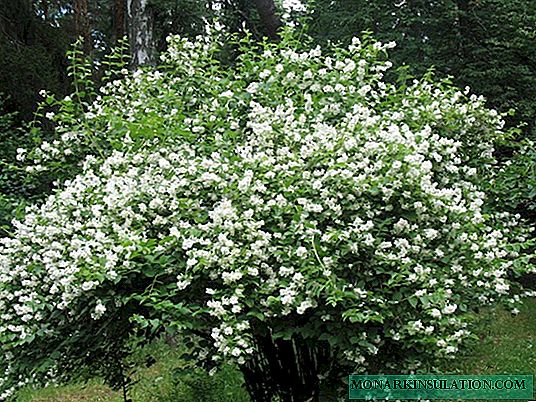Hoya is an evergreen vine, often called wax ivy. Belongs to the Kutrov family.
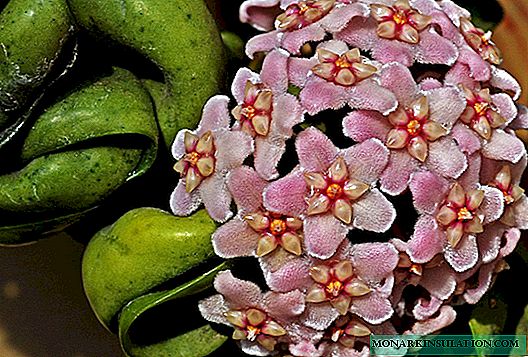
The main plant species grow in southeast Asia, in China and India. Several varieties of hoya can be found on the islands between the Pacific and Indian Ocean.
Description
Hoya is among the flowers of epiphytes, therefore, during growth, it needs large shrubs or trees to support.
Wax ivy has white or bright pink flowers in the shape of stars, their diameter is about 15 mm, and the number in the inflorescence is 15-20 pieces.
The leaves are dark green in color, twisted in the form of curls and firmly located on the descending process. In length, they reach 5 centimeters, in width - 7-10 centimeters. Foliage is juicy, dense and fleshy, it is this feature that led to the fact that wax ivy was ranked as a group of succulents.
Kinds
There are about 300 varieties of hoya, but only some of them can be grown indoors.
| View | Description |
| Kaudata | Inhabits the territory of Thailand and Malaysia. The flower was first discovered in 1883. It has dense ovoid leaves, a heart-shaped base. Spotting of different colors is present - from pinkish to dark green in color. The lower part is reddish, the upper one has a silvery splash. The flowers are small, odorless, the color is white and red. |
| Silver splash | Cuttings of the leaves are dense, contain a dense fluff, which undergoes thinning as the flower grows. The buds are white and red. Leaves of a reddish hue. |
| David Cumming | A rare type of wax ivy. It differs from others in salmon-pink flowers with a bright yellow center. In the evening it emits a pleasant aroma of caramel. Foliage lanceolate, veins barely distinguishable. |
| Calistophyll | The leaves are wide, have dark green veins. The flowers are milky yellow; from 18 to 20 are present in the umbrella. It produces an unpleasant odor during flowering. |
| Imperialis | The largest variety of wax ivy. The habitat is the peninsula of Malacca. The flowers have a dark red color, the center is white. During twilight it emits a pleasant aroma. |
| Locky | Endemic plant of Vietnam. With quality care, it is able throughout the year to please with flowers of pearl-pearl color. The ivy aroma reminds chocolate and amplifies in the evening. |
| Lacunose (concave) | The leaves are dark green, in the form of a rhombus, the edges are bent, so that a hollow is obtained, which gave the name of the variety. Flowers are collected in inflorescences of 15-20 pieces, velvety white with a yellow crown in the middle. |
| Shepherdie | Flowers of a pale pink color with lowered corollas. The foliage is long and narrow, has the shape of a boat, in the center of which is a bright green vein. |
| Karnosa (fleshy) | Liana, reaching a length of 6 meters. The leaves are small, oval, but rather dense, with a waxy coating. They are dark green with silver strokes. Flowers are fragrant, pink and white. |
| Beautiful (Bella) | Bella's shoots constantly hang down, and the bush itself branches strongly, so the plant is referred to as ampelous. The leaves are small, have an ovoid-lanceolate shape, green in color. The buds are white, 7-9 umbrella inflorescences are present. |
Indoor Hoya Growing
Care at home for this flower does not cause any difficulties, because the liana does not even require annual transplants. As a rule, every two to three years is enough to change the pot.
Pot selection, soil, transplant
Hoya is suitable for cultivation by ampel method, therefore, when choosing a container for wax ivy, it is worth giving preference to a cache-pot.
The soil for the plant can be of two types:
- peat, river sand, humus and sod soil are mixed, everything is taken in equal proportions;
- loamy-soddy soil, land from a greenhouse and humus are combined, ratio: two parts of loam and one part of other components.
You need to transplant the plant according to this plan:
- A layer of expanded clay and pebbles 40-50 mm thick is poured at the bottom of the pot. The mixture is covered with a fresh substrate, filled about ¼ of the volume of the pot.
- If necessary, install the support. At the same time, it is recommended to refuse bamboo sticks, since they often break due to the severity of the plant.
- Hoya is watered, and after 30-40 minutes is taken out of the pot. This should be done as carefully as possible so as not to harm the earthly coma.
- Ivy moves into a new flower pot, a substrate is added around the edges.
The first few weeks after the plant is transplanted, it should be moderately watered and protected from direct sunlight.
Watering
Despite the fact that hoya is ranked as a large tropical plant, it absolutely does not withstand excess moisture:
- Most of the types of wax ivy require moderate watering.
- If the hoya variety has dense leaves, then between waterings, the top layer of soil must dry out by 20-30 mm.
- Varieties of hoya with hard, but thin leaves, you need to constantly maintain a lump in a moist condition.
Top dressing
With active growth and flowering, the plant requires top dressing twice a month. But you should not overdo it, ivy tolerates a deficiency of useful components better than their excess.
It is recommended to give preference to mineral fertilizers, they should be diluted a little more than indicated in the instructions, this will protect ivy from possible burns.
Cropping, support
Most varieties of hoya quickly grow up. Initially, the stems are elastic, but become brittle as they grow and are easy to damage. Therefore, after planting in the ground, the plant needs support. Arches from vines or bamboo lattices can serve as a support. You can use the external type: mesh, wooden grate on the wall, a string stretched nearby.
The main thing to remember is that it is strictly forbidden to cut off “stumps” formed instead of fallen flowers. It is on these stumps in the next flowering period that buds will form.
Bush-type wax ivy is nipped annually, removing two or three vertex buds on all shoots. The first time the procedure is performed after the formation of the fourth sheet.
Different periods: flowering - peace
Wax ivy begins to bloom in the summer.
In order to stimulate the flowering process, it is required in May and September for several hours to dip the flower in water, previously heated to thirty degrees.
After that, the substrate is carefully dried. If you are bathing the entire plant, then the procedure time should be reduced to half an hour.
In the cold season, the plant should be given the opportunity to "rest". A dormant period is indicated by a slowdown in liana growth. As a rule, this is observed with a reduction in daylight hours.
In winter, in the storage area of the plant, you need to reduce the temperature, reduce the amount of watering and temporarily abandon fertilizers.
Moisture deficiency during the cold season contributes to more abundant flowering of hoya.
Breeding
Propagation of the plant, possibly in the following ways:
- cuttings;
- by seeds;
- layering.
The most popular breeding method is the one where cuttings are used. To manage to propagate the flower, you need to follow the step-by-step instructions:
- In the spring, cuttings (ten centimeters long) are cut from the tops of shoots formed last year. Each stalk should contain 3-4 internodes.
- A section of the stem is treated with Zircon, Epin or any other phytohormone.
- The planting pot for planting is filled with a mixture of sand and peat, and then moistened.
- Cuttings are deepened into the soil, and then carefully rammed so that there are no voids.
- Seedlings are covered with a bag, can or film.
- The plant is placed in a warm and bright place, the temperature should be + 18- + 24 degrees.
- Planting material is regularly moistened and ventilated.
- After the appearance of the first leaves, the cuttings are transplanted into small pots or pots.
For reproduction using layering, the following actions are performed:
- On several shoots in the area between the growth points, the blade, make a small annular incision.
- The slice is wrapped with sphagnum moss, which is pre-moistened in a solution of a biological stimulator. The top of the slice is covered with foil or film.
- After the formation of the roots, the tip of this shoot is cut off, and the flower moves to a new planter.
For seed germination, the following manipulations are performed:
- The strongest seeds are selected and dried for 2-3 months.
- The seeds are planted in a mixture of universal soil and finely chopped sphagnum moss (components are taken in a 1: 1 ratio).
- Similar conditions are created as for the germination of cuttings.
- After about a week, seedlings should form. From this time, you need to monitor the moisture content of the substrate, it should be slightly moist.
- After the seedlings form three to four leaves, they are transplanted.
Errors and their correction
When caring for ivy, certain mistakes may be made that need to be addressed immediately.
| Common mistakes | Cause | Fix Features |
| The formation of yellow spots on the foliage. | Exposure to direct sunlight, burns. | In the spring and summer, the plant must be placed in partial shade. |
| Falling foliage. | Excessive soil moisture, can be combined with low air temperature. | Compliance with the watering regime, it is necessary to give the soil time to dry. The lower the room temperature, the less moisture the plant will need. |
| Blanching foliage, slowing the growth of stems. | Lack of useful components. | It is required to increase the amount of fertilizing or transplant the plant into more nutritious soil. |
| Puckering and killing foliage. | Regular watering with cold water. | The plant needs to be watered with water at a temperature slightly above room temperature. |
| Edges and ends of leaves dry. | High temperatures and dry air. | Humidification of the air and spraying the plant with water (the exception is the flowering period). In the cold season, the plant needs to be removed from the heating appliances. |
Diseases, pests and control measures
There are a number of diseases and pests that most commonly affect wax ivy.
| Disease and pest | Manifestations | Control measures |
| Powdery Mildew | White coating on foliage. Withering and yellowing of leaves. | - All shoots and leaves affected by the disease are cut; - Replacing the topsoil; - In the initial stages of the disease, the plant is placed in a solution of soda ash; - In severe cases of the disease, fungicides are used - Skor, Topaz. |
| Root rot. | The bases of the shoots darken. The smell of rot is formed, a thin layer of mold forms on the soil. | - Cut off all infected shoots, places of cuts sprinkled with activated charcoal; - The roots of the plant for two to three hours are placed in a solution of any of the fungicides. |
| Shield. | Solid brown tubercles form on the foliage. The surrounding tissues turn red-yellow. | - Shells of pests are smeared with kerosene; - The leaves are wiped with a solution based on soap and alcohol; - The flower is washed with warm water and processed by Metaphos. |
| Aphid. | Small yellow-green insects cling to the tops of plants. | - Heavily damaged shoots are cut off; - The flower is sprayed several times a day with onion or garlic solution. |
Occasionally, a plant may be affected by a spider mite.

Signs
There is a superstition that wax ivy can bring misfortune to the house, so not all gardeners decide to grow this plant, despite all its beauty.
In Russia, there is another belief. It is believed that a hoya can survive a man from home, and a plant beats off suitors from a young unmarried girl.
Wealthy people are also not recommended to grow the plant, as it portends losses.

